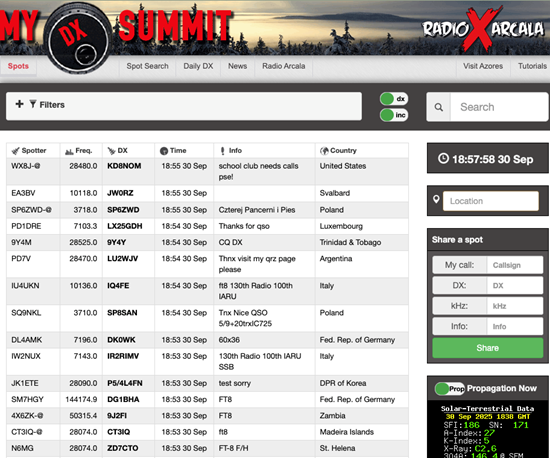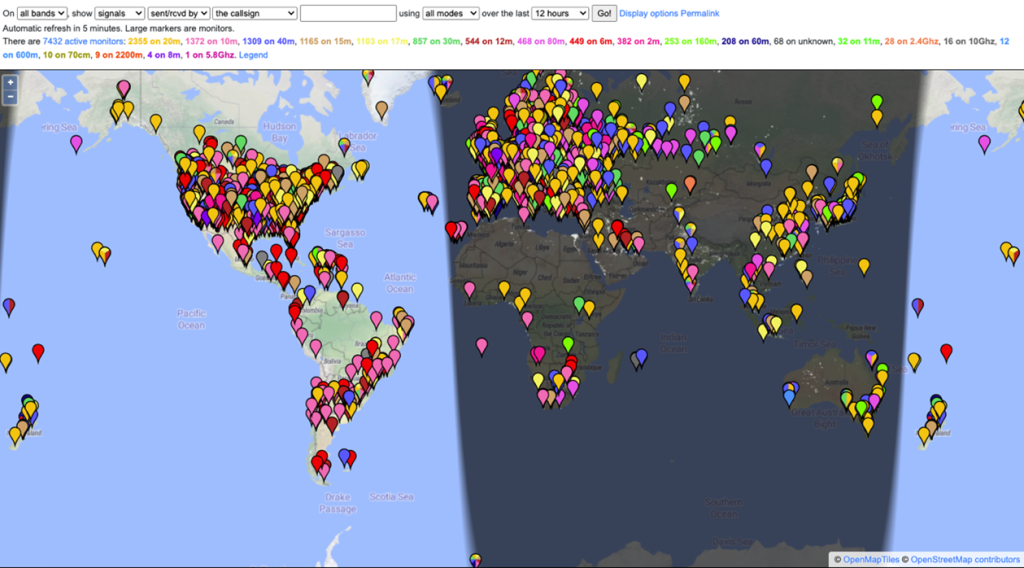Choosing the right ham radio band is a decision we all make when we fire up our transceivers. Whether you are a beginner or an experienced operator, you want to pick the frequencies most likely to produce QSOs at any given time.
HF bands (1.8-29.7 MHz; 160-10 meters) are best for long-distance communications. NVIS (Near Vertical Incidence Skywave) is ideal for regional communications on 160-40 meters. HF bands, 40 meters and above, are known for long-distance communications because radio waves at these frequencies can bounce off the ionosphere, enabling worldwide communication.
Before diving into specific bands, be sure to consider the following:
- Your license privileges: Different license classes grant access to specific bands. What bands are you allowed to use?
- Operating interests: Are you interested in CW (Morse code), digital modes, voice communication, or emergency communications? Some bands support different modes better than others.
- Your antenna farm: What HF antennas do you have available? Larger antennas are generally required for some HF bands. However, more compact and stealthy versions are available for those who live in HOAs.
- Propagation conditions: The sunspot cycle, time of day, and atmospheric conditions affect the propagation of radio waves on different bands. For a quick summary of conditions, check the solar-terrestrial data at www.hamqsl.com. The same information can be found at many ham-oriented sites, including QRZ.com.
Get an Earful
For starters, the best way to see if the band has activity is to tune in and find what’s there. Listen…and then listen some more. Most new transceivers come with a waterfall display that will give you a visual overview of a particular band’s activity at a glance. Immerse yourself in real-world experiences.
Keep notes about which bands work best from your location and at different times of day/solar conditions. Generally, frequencies from 14 MHz to 29.7 MHz are used for long-distance communication during the day, and frequencies from 1.8 MHz to 10 MHz are used at night. However, this can vary depending on several factors, and different frequency bands may be better suited for various types of communication (e.g., voice vs. data).
You can also enlist the help of online tools to monitor band activity and band conditions. There are many available, ranging from simple to very detailed. To pick the best band at the moment, try some of these:
DX Clusters: These are a great way to find where the action is on the bands. A quick glance will reveal which bands are active, any interesting/rare/special event stations that you might contact from your location, and generally how good the conditions are. The more QSOs that pop up per minute, the better the conditions. You can also filter results by band and mode. Examples include DX Watch and DX Summit.

Reverse Beacon Network (RBN): The RBN enables amateur radio operators to view in real-time which stations can receive their transmissions when they send a CQ. This helps hams to assess band conditions, track their station’s performance, and improve their chances of making contacts.
PSK Reporter: This is a website and network for amateur radio operators to see where their digital radio signals are being received worldwide. It works by collecting reception reports from various digital mode software, such as WSJT-X and FLDIGI, which are then displayed on a global map. It is a bit complicated—check the information page first. There are also several good videos available.

Get on the Bandwagon
What can you expect on specific bands? Here’s a brief description of each. You’ll also discover why 40 and 20 meters are popular bands—and a good place to call CQ.
- 160 meters—1.8 to 2.0 MHz
Known as the Top Band, 160 meters is primarily a nighttime regional band. Nighttime range is usually very good, extending from next door to about 500 miles or more. Worldwide DX is possible on this band, especially during the winter months. Atmospheric noise from lightning can make this band a challenge during the summer thunderstorm season. - 80 meters—3.5 to 4.0 MHz
80 meters is actually two bands—80 and 75 meters. Like 160m, 80/75m is for shorter distance chats during the daytime. At night, the range can often extend several hundred miles or more. The best conditions are during the winter months, particularly near the solar minimum. 80/75m exhibits good skywave propagation after dark during certain parts of the year, allowing you to literally work the world. - 60 meters—5.330 to 5.405 MHz
This is an interesting band. It offers propagation similar to 80/75 and 40m with regional daytime and extended nighttime coverage. However, it’s also an odd band for several reasons. There are only five channels, and you are limited to 2.8 kilohertz of bandwidth centered on one of the available channels.
Although the power is limited to 100 watts Effective Radiated Power, you may find it perfect for low-power digital modes such as FT8 or CW.
More information on operating on 60m can be found here. - 40 meters—7.0 to 7.3 MHz
No matter your ham radio interest, 40m supports it. CW? Plenty of it. Digital modes? It’s there, almost all day, every day. Rag-chewing? You can almost always start a conversation in North America and work on DX after sunset. This is also a good QRP band. Stations with less than five watts can make worldwide contacts. Between late afternoons and an hour or so after sunrise, hams from all over the world communicate to some degree.
So what’s not to love about 40 meters? There are still some shortwave broadcast stations that operate on these bands at night, but the number is dwindling.- Note: 40 meters has the potential to be active 24 hours a day.
- 30 meters—10.1 to 10.15 MHz
If you’re into CW, RTTY, and other data modes, you’ll love this band. Like 40m, this is a good DX band and always best at night, but it can also offer long-distance contacts during daylight hours. You’re limited to a maximum of 200 watts, but this puts everyone on more or less equal footing. - 20 meters—14.0 to 14.350 MHz
You want DX? This is the place. 20 meters is best for DX around sunrise and sunset, but you’ll find stations at all hours if you’re patient enough. Don’t write it off—just when you think it’s dead, a station suddenly pops up. Don’t hesitate to call CQ. You never know who might come back to you.- Note: 20 meters has the potential to be active 24 hours a day.
- 17 meters—18.068 to 18.168 MHz
There is little of the crowding found on other bands and more of a laid-back attitude prevails. 17 meters offers very good propagation at times and is often more reliable than 15 meters. The atmospheric noise also seems quieter here than on 20m. - 15 meters—21.0 to 21.450 MHz
15 meters continues the trend seen in the 20- and 17-meter bands. It opens later than 17 meters and closes sooner. As the sunspot count rises toward the next peak, 15 meters will begin opening up during the day. Being higher in frequency, it suffers even less D-layer absorption than 20 meters, so signal strengths tend to be good for open paths.
The band is also large, with 450 KHz end to end, providing plenty of room for DXers and rag-chewers to coexist. The skip zone on this band is somewhat larger than what is observed on 17 meters, making DX contacts more likely than those with nearby locations. - 12 meters—24.89 to 24.99 MHz
12m band propagation can be excellent during solar maxima for long-distance DX contacts during daylight hours. In late spring and summer, Sporadic-E clouds can also provide short-term openings for short- to medium-range contacts, up to about 1,000 miles. It’s a useful WARC band that can provide opportunities even when 10m is closed. - 10 meters—28.0 to 29.7 MHz
The 10m band is known for skywave propagation. Radio waves bounce off the F2 layer of the ionosphere, enabling signals to travel thousands of miles over the horizon. This is often referred to as “skip.” An abundance of sunspots during the solar maximum provides the most effective long-distance openings, with signals potentially traveling around the globe.
If sunspot numbers are low, Sporadic-E can allow communication over several thousand miles. This typically occurs mainly in the summer and for a few weeks in early winter, but it can happen at any time. It is also a good option for local communication up to a hundred miles provided you have a good antenna and an amplifier.
Understanding the HF Bands
Several factors affect HF communication, including solar activity. This can impact the ionosphere and the amount of ionization, which in turn can influence the refraction of HF radio waves. The frequency of the HF radio signal itself can also affect its propagation, as different frequencies may be refracted or absorbed by the ionosphere in different ways.
Terrestrial weather can influence HF radio propagation by altering the ionosphere or by modifying the signal as it passes through the atmosphere. Geomagnetic storms, driven by space weather, can cause disruptions in HF radio communication by altering the properties of the ionosphere.
Timing is everything. The ionosphere is more ionized during the day due to the presence of solar radiation. That means HF radio waves are more likely to be bounced back to Earth at certain frequencies. At night, the ionosphere becomes less ionized, and the signals refracted back to Earth shift to lower frequencies. The ionosphere’s ionization levels vary depending on the season, which can affect the frequencies returned to Earth.
Geography also plays a part. The angle at which radio waves strike the ionosphere is determined by the relative locations of the transmitting and receiving stations. It can affect how they are refracted back to Earth and the distance they travel.
Each of the HF bands has its own personality and appeal, as well as a few drawbacks. No band is perfect, but 40 and 20 meters have a reputation for being active a significant amount of the time.
It’s a good thing that hams have access to a broad range of the spectrum. Having a variety of HF frequencies is essential because the propagation of these radio waves depends heavily on atmospheric conditions, which are constantly changing. No single frequency can provide reliable long-distance communication at all times.

